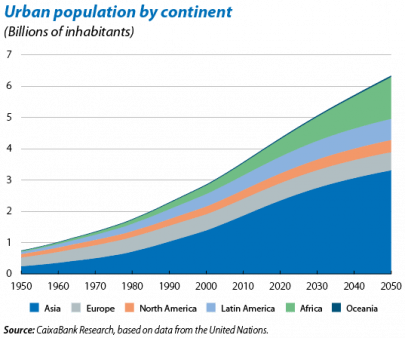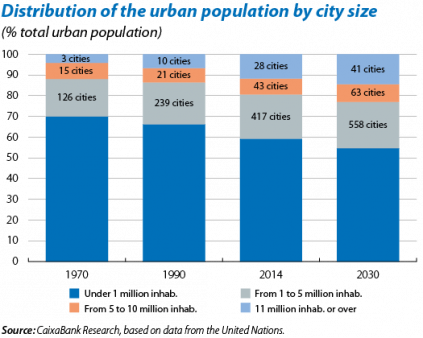Towards an increasingly urban world
At the end of the 19th century Sir Arthur Conan Doyle, the creator of Sherlock Holmes, wrote an article that is hard to associate with the world-famous detective: «On the geographical distribution of British intellect». This article listed what Conan Doyle called «British worthies» and he was surprised to find that 235 of the 824 celebrities identified were from London: although London only accounted for 7% of Britain's total population, the city contributed almost one third to the United Kingdom's production of talent. But this is not just an old anecdote from the Victorian era. Based on contemporary statistics, the data on the distribution of human capital in US cities leave no room for doubt: the larger the city, the greater the share of population with higher qualifications. Whereas 41.7% of the labour force has a university qualification in the New York-Newark-New Jersey conurbation (with a working age population of 10.5 million people), this percentage falls by 10 pps when the urban area comes from the group of conurbations with under one million people of working age.
For an economist, a city accumulating more human capital than other smaller urban areas is likely to mean that its productivity is also higher. In aggregate terms, there is a high correlation between a country's urbanisation rate (i.e. the share of its total population living in cities) and its degree of development. And according to data from the United Nations, this is actually the case: on average, those countries with 80% and 60% of their population living in urban areas have, respectively, high and medium incomes, while those with a 30% urban population have low incomes. If we add to this the fact that, in 2007, the world's urban population exceeded its rural population for the very first time, and that this trend towards greater urbanisation is expected to continue in the future, the conclusion seems clear: we are moving towards a more urbanised and more prosperous world.
This economy of the future, let's say by 2050, will reveal that there has been a complete turnaround in just 100 years as, according to the United Nations' projections, whereas two thirds of the population was rural in 1950, by 2050 two thirds will be urban. This is due to strong growth in the urban population: between 2014 and 2050 the annual rate of growth in the urban population in less advanced countries will double that of the total population and quadruple that of advanced countries. Of course most of this rise in urbanisation will occur in Asia and Africa, accounting for 90% of the increase: by 2050 half the world's urban population will be concentrated in Asia (25% in China and India) and 21% in Africa.
But will the nature of cities change to any great extent? Are we moving towards a world of megacities? According to the United Nations, the distribution of the future will be similar to the current distribution albeit with a greater trend towards large agglomerations. Looking at a somewhat nearer timescale, by 2030 the percentage of the urban population living in megacities (i.e. with over 10 million inhabitants) will be 14.4% of the total urban population, somewhat higher than the figure of 11.7% of 2014. In 2030 there will be 41 megacities, four of them European: by ranking of population, Istanbul, Moscow, Paris and London. The urban population living in the large city category (from 5 to 10 million inhabitants) will go from the current figure of 7.7% to 8.6%, and from 21.3% to 22.3% for medium-sized cities (from 1 to 5 million inhabitants). However, smaller urban areas of one million inhabitants or fewer will house a smaller share of the population: whereas in 2014 the rate was 59.3% by 2030 it will be 54.7%.
The phenomenon of urbanisation is therefore relevant and will be even more so in the future. Given this situation, a good understanding of the economic phenomena that lead to urban growth is vital. The justification given for the existence of cities from an economic point of view is that people and activities tend to concentrate together because the benefits of agglomeration outweigh the costs. But this general assertion leaves a lot that requires further clarification. The next three articles in this Dossier analyse in detail how economies of agglomeration are generated; i.e. the productivity gains that occur when population density increases (see «The keys to the city of the future») but also the costs involved (see «The cost of city life: the diseconomies of agglomeration»). We also examine a particularly important market for urban growth, namely the labour market, in which the economies and diseconomies of agglomeration balance out (see «The urban factor of the labour market»).
None of these analyses is trivial because the urban economy is notably complex, especially as there are phenomena that affect both benefits and costs. Such is the case of a situation that has been growing over the last few decades, namely technological change (in particular the development and spread of information and communication technologies). These new technologies can encourage a different spatial pattern from the traditional one. They might especially be reducing the advantages of agglomeration economies but could also be reducing some of its costs as well. In those cases where maximum advantage is taken of new technologies, the range of personal choice available in terms of where to live and work is likely to be expanded to a degree we have never seen before.
All this intellectual exercise is inevitable because urban growth is important, and not only because of the growth per se but also because of its association with increased activity at an aggregate level. For example, Hsieh and Moretti (2015) point out that the limited housing supply in the US between 1964 and 2009, by reducing labour mobility, pushed down average annual growth by 0.3%, the equivalent to a cumulative impact over 35 years of 13.5% of GDP.1
Conan Doyle was probably right to be surprised at the concentration of talent in Victorian London. Now we have to move beyond mere statement and further our understanding of the implications of urbanisation using the tools of economists. Because, when all is said and done, an increasingly larger proportion of the population lives, works and relates to each other in our cities. These are also places where productivity is high, although agglomeration also entails costs. New technologies are also likely to foster new equilibriums between agglomeration economies and the costs associated with population density. And all this, added together, has an effect that goes beyond the local economy, reaching an aggregate level. The time for cities has probably arrived. And therefore the time for the urban economy. Why not drop by and have a read: visit the articles as if they were different neighbourhoods in the same city to discover why cities should be the focus of analysis by economists and of interest to the well-informed reader.
Àlex Ruiz
Macroeconomics Unit, Strategic Planning and Research Department, CaixaBank
1. See Hsieh, C. and Moretti, E. (2015), «Why Do Cities Matter? Local Growth and Aggregate Growth». NBER Working Paper, no. 21154.




